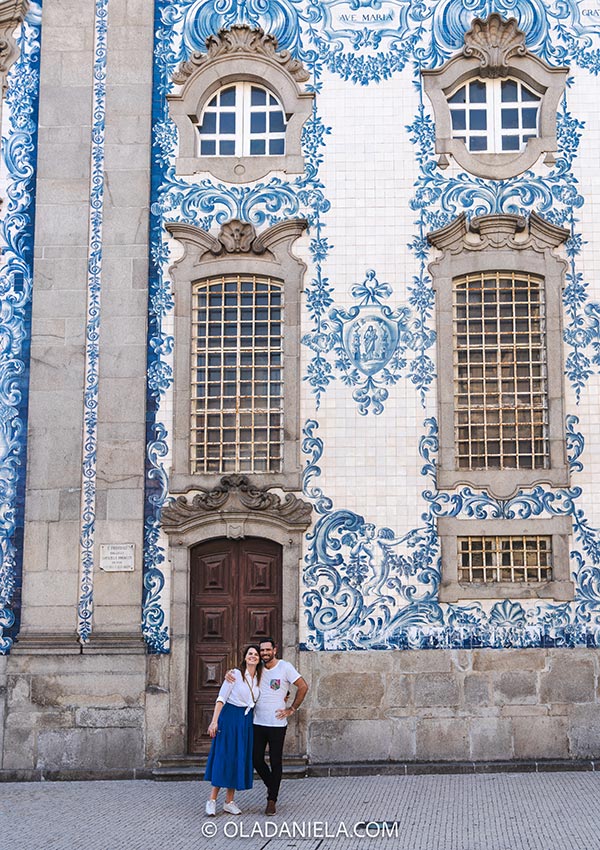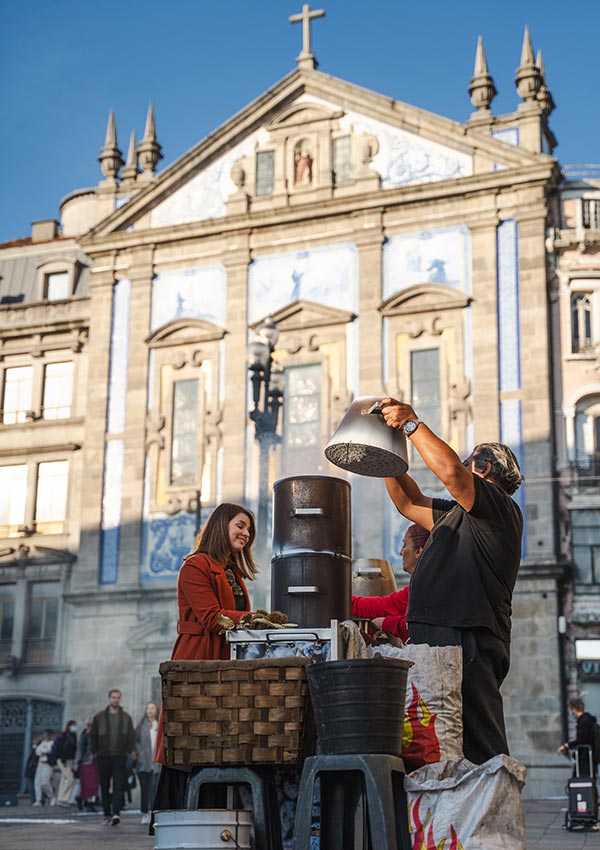It doesn’t matter how many times I visit Porto, I’m always blown away by the city’s cultural legacy: tiles.
Hand-painted tiles adorn the facades of buildings, palaces, and churches, some dating back centuries with many narrating stories of Portugal’s past with vibrant colors and intricate designs. Azulejos are really one of Portugal’s most important artistic treasures.
One thing friends often comment when they arrive in Portugal is “wow, the tiles are truly everywhere”, and indeed you’ll find incredible hand-painted azulejos and tiles everywhere in big cities, but there are a handful of extra special places in Porto worth seeking out.


When it comes to sightseeing, you can’t skip out Porto city’s famous azulejo-clad landmarks, from the stunning São Bento Train Station with its 20,000-tile entrance, to the blue-hued Chapel of Souls.
Below you’ll find a complete guide to Porto’s best azulejos, from hidden treasures tucked away to breathtaking azulejo-covered buildings that might just take your breath away (as cliche as that sounds) with their beauty as you turn the corner. From the buzzing streets of Ribeira to the inside of the Sé Cathedral, let’s look at how tiles bring together past and present of Porto and its culture.
This guide includes details on where to find these tiled buildings, plus a map and details on tile-painting workshops.
I’m a Portugal-based tile lover and I’ve shared some deeper tile photo blogs about a handful of the destinations mentioned below. Check them out to see more photos!

Read next:The best tile painting workshops in Porto
Contents
ToggleWhy are there so many azulejo tiles in Porto?
Azulejo is the Portuguese (and Spanish) word for glazed ceramic tile. While the history of tiles in Portugal dates back hundreds of years, tiles really had their golden period in the mid 19th to early 20th century. During this time, the art of tiles became popular and a lot of Porto’s old churches received a “modern” update with hand-painted tiled facades designed and executed by painters and artists.
The invention of layered stencils then allowed local factories to produce tiles faster with a stamping technique. This made it cheaper, and suddenly more people were able to afford this form of cultural expression and covered their houses with them. Tiles not only look beautiful – they help keep the damp out of houses, making homes warmer in winter.


Like a fashion trend of sorts, buildings in Portugal’s major cities, like Lisbon and Porto, are now covered in colourful azulejo tiles. I love them because they make the streets here so fun, bright and unique. But it’s not all rosy. Porto’s century-old tiles have been protected by law since 2017, but many are still at risk during renovations. I’ve been a long-time follower of Os Azulejos do Porto, a non-profit project tracking the heritage and history of Porto’s tiles and there’s often sad news on Instagram regarding lost heritage.
Don’t buy antique tiles. Instead join a tile-painting workshop and create your own take-home souvenir. Join this local artist for a tile-painting workshop in one of Porto’s most beautiful gardens, or have fun with this tiles and cocktails class.
You’ll find beautiful tiles all across the city, but below I’ve highlighted the very best, unique azulejo tiles in Porto.
Why are Portuguese tiles often blue?
It’s said that Europeans fell in love with the fine elegance of Chinese porcelain, which was often white with blue. To create this colour artists needed an ingredient not found in Europe (at the time), and with rarity comes exclusivity – making blue tiles a symbol of wealth. The Dutch started making blue-and-white tiles in the 17th century, and the Portuguese loved them so much they imported plenty to decorate buildings. The rest? History.
Read next: How to spend 48 hours in Porto
➼ Wish someone could shortcut your Portugal research? ➼ Talk to me – I offer 1:1 video calls to help cut through the noise and plan your perfect Portugal itinerary. Find out more here.
The best azulejo tiles in Porto
Igreja do Carmo


Porto has many beautiful tile-covered churches, and Igreja do Carmo is definitely one of the most beautiful. Better yet, it’s super close to popular Porto tourist stops like the Clérigos Bell Tower and Livraria Lello bookshop.
The 18th-century Baroque church only received its glorious blue-and-white tiled side in 1910. The huge multi-storey work was designed by Silvestre Silvestri and painted by Carlos Branco, and it depicts the founding of Carmelites religious order on Mount Carmel.
Curiously, Carmo is actually a twin church with the next door Igreja do Carmelita. The two sit side-by-side, connected by a tiny house that’s only a metre or so wide.
Location: Rua do Carmo
Porto’s Cathedral / Sé do Porto


The Sé do Porto is more than 900 years old. Works on Porto’s huge cathedral started in 1110 and as you can imagine the imposing stone building has gone through many changes in that time. You’ll spy Gothic, Romanesque and Baroque architecture and influence, and – of course – stunning tiles.
The blue-and-white tile scenes inside the Gothic cloisters were painted by Valentim de Almeida between 1729 and 1731, depicting the life of the Virgin Mary and Ovid’s Metamorphoses. On the upstairs terrace of the Sé do Porto there’s also these huge tile panels by António Vidal.

Read the full story & see more photos
Location: Terreiro da Sé
São Bento Station
If you make it to Porto by train, lucky you. If you arrive by plane, car foot or bicycle – it’s still essential to stop by the entrance hall of the city’s central station, Estação de São Bento.


Lining the grand hall are 20,000 insane pictorial tiles. Here every tile tells a story, and it’s not the usual religious illustrations. Back in 1900, Portugal’s King Carlos I laid the first stone of this French Beaux-Arts building where an old convent once stood. The real drawcard is the thousands of azulejos, hand-painted over a period of 11 years by artist Jorge Colaço.
Usually large figurative azulejo works like these blue and coloured panels are found in churches, but this isn’t a church. Instead of religious scenes showing various do-good saints, the panels represent Portugal’s history and stories.
Read the full story & see more photos
Location: Praça de Almeida Garrett
Love tiles and history? This three-hour “Tiles of Porto” walking tour covers both as you explore the cultural heritage of Portugal’s second-largest city. Book it here.
Igreja dos Congregados

When you step outside the doors of São Bento Train Station, look to your right and you’ll see Igreja dos Congregados – also sometimes known as Igreja de Santo Antonio dos Congregados (the Church of St. Anthony’s Congregation).
The “Church of St. Anthony’s Congregation” was completed in 1680, but as the story goes it’s seen many changes throughout history. Artist Jorge Colaço, who was responsible for the station’s 20,000 azulejo tiles, also painted this facade. I’m a fan of the pop of yellow!


Curiously, the church was used for hospital and military equipment storage during the 1832-35 siege.
Address: Rua de Sá da Bandeira 11
Location:
Chapel of Souls / Capela das Almas


Capela das Almas de Catarina or Capela de Santa Catarina, is an 18th-century chapel covered with a casual 15,947 tiles. This is one of Porto’s most magnificent and most photographed attractions and the blue-hued chapel is conveniently located along Rua de Santa Catarina, the city’s pedestrian mall in Santo Ildefonso neighbourhood.
It’s just around the corner from the Mercado do Bolhão, Porto’s must-visit fresh marketplace.
The name Capela das Almas means Soul’s Chapel, and while the building itself is some 200 years old the tiles were only added in 1929. Artist Eduardo Leite designed the illustrations and they were made in Lisbon by Fábrica de Cerâmica Viúva Lamego, which is still a working tile factory.
Read the full story & see more photos
Location: Cnr Rua Catarina & Rua de Fernandes Tomás
Igreja de Santo Ildefonso


The Church of Saint Ildefonso always sneaks up on me. You pop around the corner and suddenly this 18th-century church with its staircase comes out of nowhere. You’ll find it close to Rua Catarina, making it easy to combine with Chapel of Souls.
This church was declared a UNESCO World Heritage Site in 1996, along with the São Bento Railway Station. The Baroque-style building was constructed in 1739, but like other churches in the city, the tiles were added later.
Much later. In this case, the 11,000 azulejo tiles adorning the Igreja de Santo Ildefonso were only added in 1932. Portuguese painter Jorge Colaço was behind the entire façade, and he was responsible for the train station too.
As you might expect from a church, these tiles show the life of St. Ildefonso along with stories from the Eucharist.
Tile tip: Don’t buy tiles or azulejos at a flea market – they are quite likely stolen from the streets. Instead, buy tiles from living artisans or make-your-own with a tile painting workshop.
Porto’s Downtown Neighbourhoods


Walking around Porto is like an open-air museum. I find the city to be extremely walkable (despite the odd hill or staircase) and I suggest just getting lost. You’ve got Google maps to find your way back home, so just follow your camera to wherever the next pretty tile takes you. After a dozen or so visits to Porto, I still find myself exploring new alleyways and streets, finding new tile designs and patterns.


Did you know Lisbon has different tiles to Porto? There’s not a huge overlap because both cities had their own tile-painting factories. Porto once had eight huge tile-making factories. One major difference I see is 3D ceramic tiles – Porto has a range of three-dimensional tiles while Lisbon’s are all flat.
Banco de Materiais / Bank of Materials
Close to Igreja do Carmo you’ll find Banco de Materiais – the Bank of Materials. This museum (of sorts) was created by Porto’s City Hall back in 2010. The idea was to preserve, show off, and raise the profile of Porto’s historic building elements – mostly tiles, ceramic edges, and decorative pieces like iron railings.


It gives tourists the chance to admire and appreciate Porto’s cultural heritage, thus raising the value of historic Porto. And it gives building owners the chance to restore their buildings, where beautiful azulejos tiles have chipped off or been destroyed by the elements.
Yes, it’s a bank where building owners can request to access tiles etc if they have a building that needs some. Consultations (and materials) are often free, but I’ve heard it can take a while.
If you’re a history or tile fan, drop in for 10 minutes. There’s not much information but the tiles and materials are beautifully displayed for you to oggle at.
Location: Praça de Carlos Alberto
Casa da Música
A little out of the way, I’ve not yet been to the Casa da Música as I’ve been waiting for a concert to collide with when I’m there. This performing arts space was built in 2005 and fuses modern design with cultural heritage. It’s said the Dutch architect, Rem Koolhaas, wanted something that merged Dutch and Portuguese culture, hence why he choose to use old-style blue-and-white illustrated tiles in the contemporary building.
If you take guided tour of the building they’ll show you the VIP room, which is covered in stunning tiles. There’s an entry fee, but the Porto Card gets you a 50% discount.
Location: Avenida da Boavista
Map of Porto tiles
Want someone to show you around? This three-hour “Tiles of Porto” walking tour covers both as you explore the cultural heritage of Portugal’s second largest city. Book it here.
Here’s a map so you can see where the best tile spots in Porto are. Use this to design your trail or find tiles close to points of interest.
Where are the best places to buy azulejo tiles in Porto?
As I mentioned above, if you want to shop for ceramic tiles in Porto be sure to know what you’re buying. Unfortunately tiles do get stolen from buildings and even monuments, and you don’t want to fuel demand. The best way to avoid taking home irreplaceable heritage is to buy new tiles made by living artists.
Here are some ideas, otherwise you could paint your own souvenir tile.
- Prometeu Artesanato: This store has both traditional replica tiles and modern, creative tiles all painted in-house. Better yet, they have small hand-painted fridge tiles, earrings and other creative applications. Great for gifts!
- Fleurdelis: This small artisan makes true reproductions of old tiles.
- Azulima: The showroom of an azulejo factory where you’ll find old-style hand-painted scenes to modern colours and even concrete floor tiles.
- Zinda: A small independent boutique that sells hand-made ceramics and tiles made by artist Adosinda Pereira. It’s super cute and right in the heart of the city.
- Crivart: This small gift store has coloured, illustrated and stamped azulejos as coasters and fridge magnets, a perfect souvenir.
Top tile painting workshops in Porto
I encourage anyone visiting Portugal to join a tile-painting workshop. Not only is it a chance to make a cool souvenir but you’ll learn more about Portugal’s tile heritage at the same time.
A tile workshop is also an ethical way to create your own souvenir – please don’t purchase any antique tiles while in Portugal. This is taking irreplaceable heritage from the streets, and only encourages the degradation of tiled buildings.

I’ve rounded up a bunch of the best tile painting workships in Porto below.
- Tiles AND cocktails? Sign up to this class with (a different) Daniela at Boiler Co-Work Studio.
- Domus Arte run two-hour tile-painting workshops.
- A local artist runs tile-painting workshops in one of Porto’s most beautiful gardens.
- Gazete Azulejos in Bonfim. Beyond tile-painting workshops, owners Alba and Marisa research, share and preserve the history of Portuguese tile making in Porto. Workshops support their non-profit digital archive called Os Azulejos do Porto. Very cool!
- Agostinha, a ceramics studio in Porto that offers tile painting classes.
Where to stay to be close to the best tiles in Porto
Basically all of downtown is close to Porto’s best tiles. Personally, I would choose to stay near Clergio’s Tower as it’s a beautiful downtown area and charming neighbourhood that gives you easy access to plenty of these landmarks. You can explore hotels on the map below.
So that’s my comprehensive list of where to find the best tiles in Porto.
Pin it



Keep reading….
- The best tile painting workshops in Lisbon, Porto and the Algarve
- I did this unique Moorish tile-painting workshop in Sintra
- Made in Portugal: 24 Best Portuguese Sneaker Brands
- Best Portuguese Menswear Brands
- My Guide to the Best San Sebastián Pintxo Bars
- Portugal Road Trip: Where to stop between Lisbon and Lagos, Algarve
- Where to shop for Portuguese ceramics
- The best Portuguese cookbooks in English













